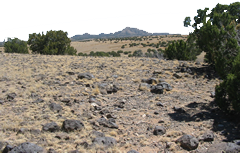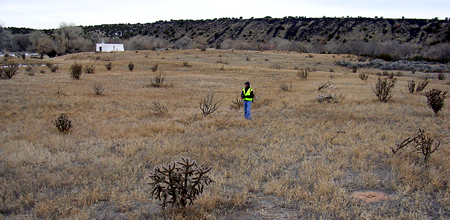
La Cienega Pithouse Village
Galisteo Basin Sites
- Lamy Jct
- Lower Arroyo Hondo Pueblo
- El Camino Real
- Chamisa Locita
- El Crestón
- Espinoso Ridge Pueblo
- La Cienega Pueblo (LA 3)
- La Cienega Pithouse Village
- La Cieneguilla Pueblo (LA 16)
- La Cieneguilla Petroglyphs
- Manzanares Pueblo
- Paa-ko
- Petroglyph Hill
- Pueblo Blanco
- Pueblo Colorado
- Pueblo Galisteo
- Pueblo Largo
- Pueblo San Cristóbal
- Pueblo San Lazaro
- Pueblo Shé
- Rote Chert Quarry
- San José de Las Huertas
- Upper Arroyo Hondo Pueblo
- Pueblo San Marcos
The La Cienega Pithouse Village is located atop a small mesa
inside a bend on the left bank of the Santa Fe River directly
above the river.
It is a multi-structure site consisting of surface roomblocks and pit structures Basalt blocks
constitute the main building material, and there are several roomblocks with
possible plaza areas. The pit structures were probably a combination of
domestic and ceremonial subterranean  constructions. Most of the pottery visible
on the surface indicates a Developmental Period site (100-1200 AD). Multiple
petroglyph panels and some possible prehistoric trails are present along the
mesa rim. Structures are concentrated
on the highest area of the mesa top. Extensive views in 360 degrees around the
structures exist, including the Cerros del Rio and Tetilla Peak, Los Cerrillos,
Cerro Seguro and mesas to the north, as well as the river valley below on the
west, and the plains to the east. Archaeologists have estimated the site
may have as many as 250 rooms. The site is one of few known Developmental
Period sites in Santa Fe County, and is a particularly large complex.
constructions. Most of the pottery visible
on the surface indicates a Developmental Period site (100-1200 AD). Multiple
petroglyph panels and some possible prehistoric trails are present along the
mesa rim. Structures are concentrated
on the highest area of the mesa top. Extensive views in 360 degrees around the
structures exist, including the Cerros del Rio and Tetilla Peak, Los Cerrillos,
Cerro Seguro and mesas to the north, as well as the river valley below on the
west, and the plains to the east. Archaeologists have estimated the site
may have as many as 250 rooms. The site is one of few known Developmental
Period sites in Santa Fe County, and is a particularly large complex.
Ceramics and structure types found at LA 166 indicate early Puebloan (Developmental) occupation. Roomblocks are manifest as rubble mounds and basalt cobble alignments, with artifact concentrations or middens generally adjacent to the structures; the actual number of roomblocks is difficult to determine accurately because they can be interpreted as separate rooms or as contiguous “arms” of room complexes, depending on the amount of surface material apparent. Pit structures recorded appear to be generally 10m+ in diameter, based on surface estimates. Based on the seeming large size of the pit structures, some may be ceremonial.

© New Mexico Office of Archaeological Studies, a division of the New Mexico Department of Cultural Affairs.
The Center for New Mexico Archaeology
7 Old Cochiti Road
Santa Fe, NM 87507
505-476-4404
Fax: 505-476-4448

